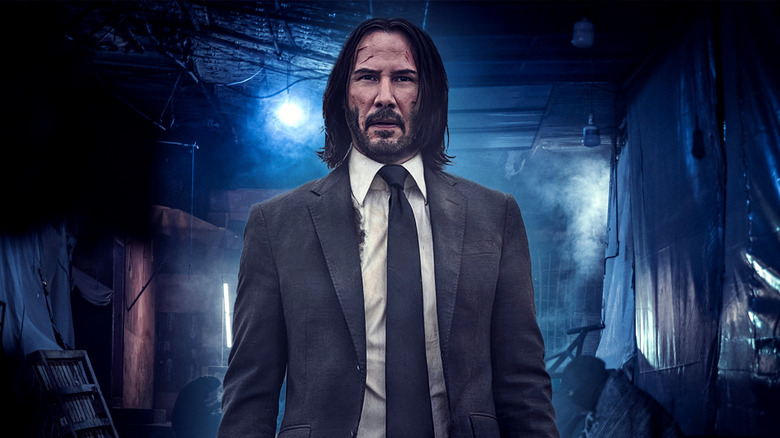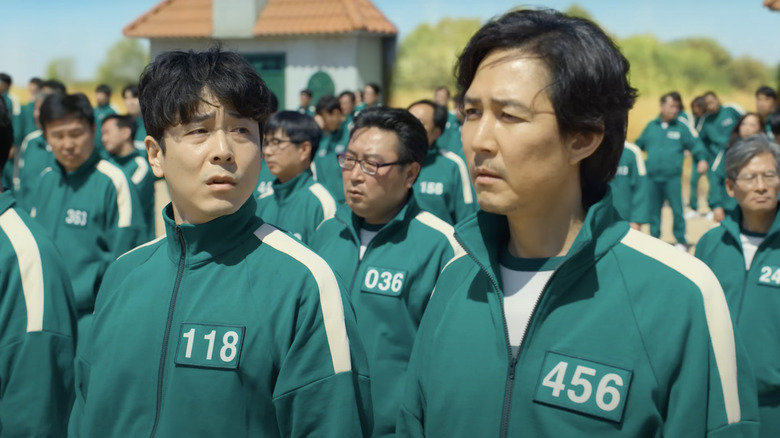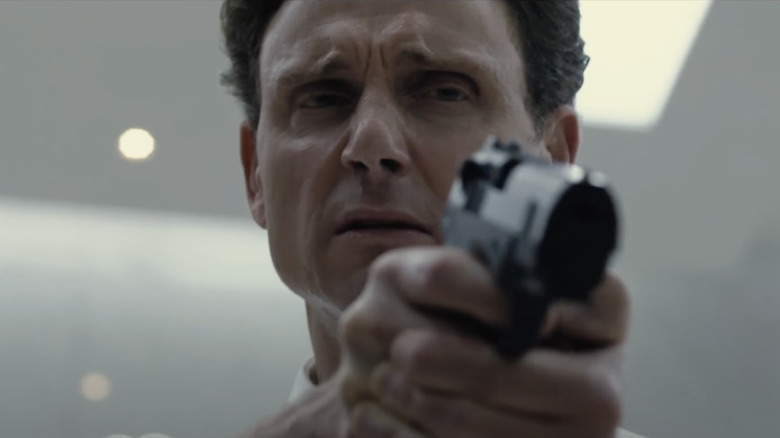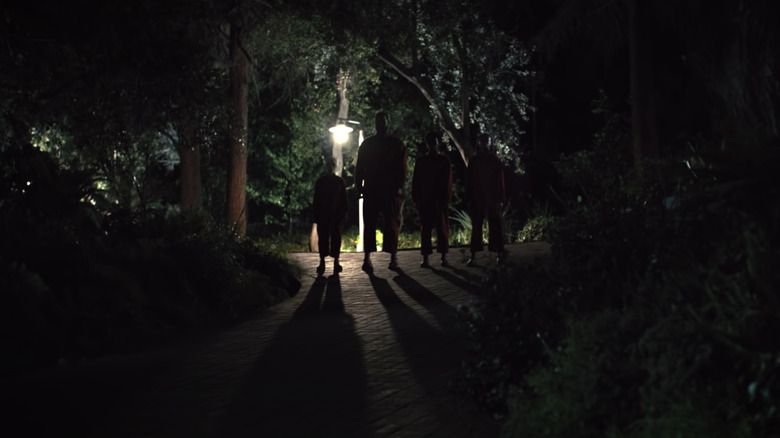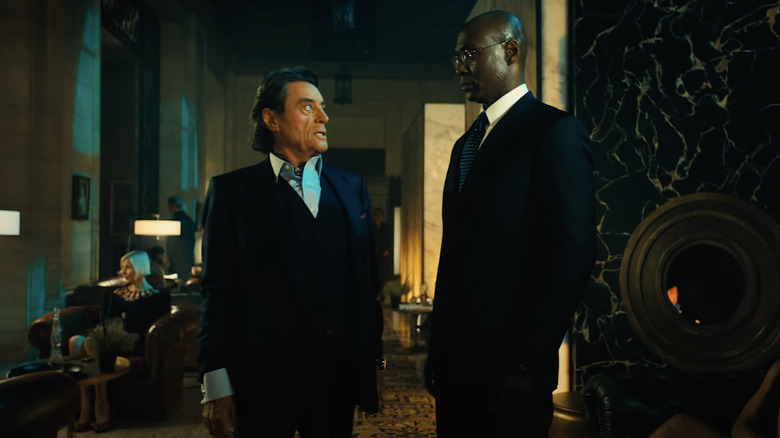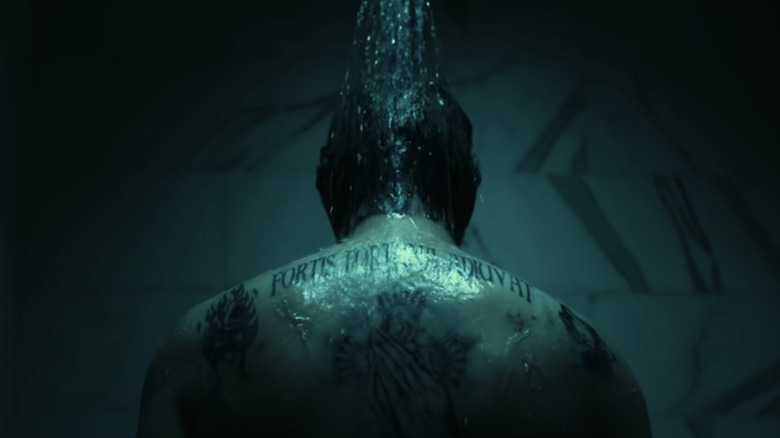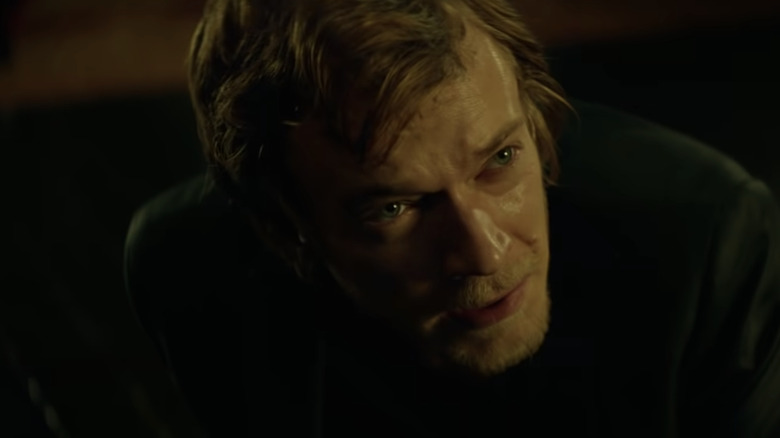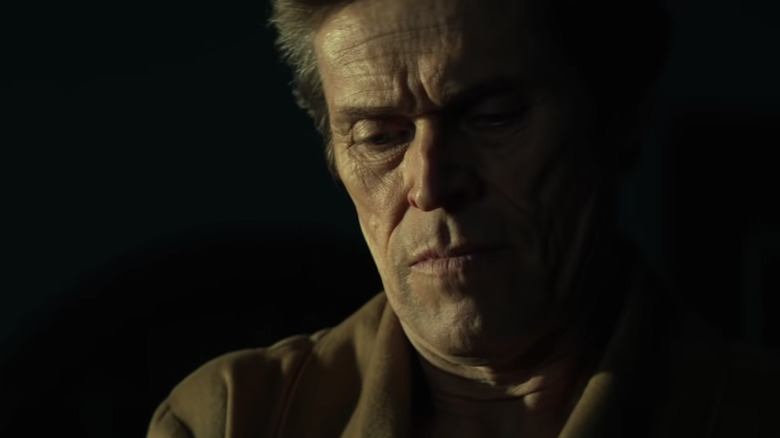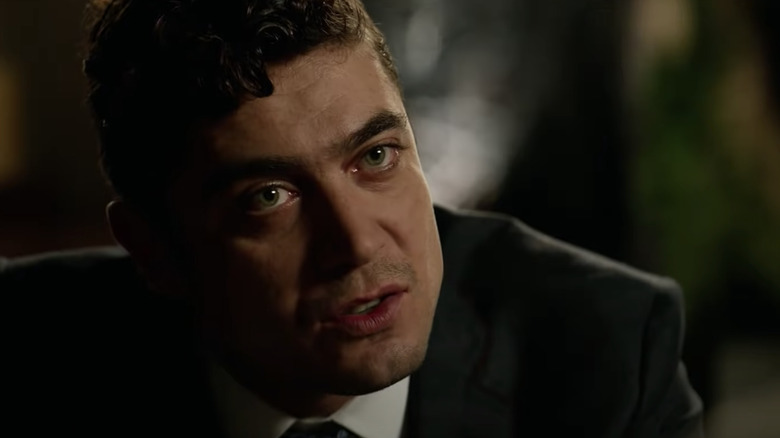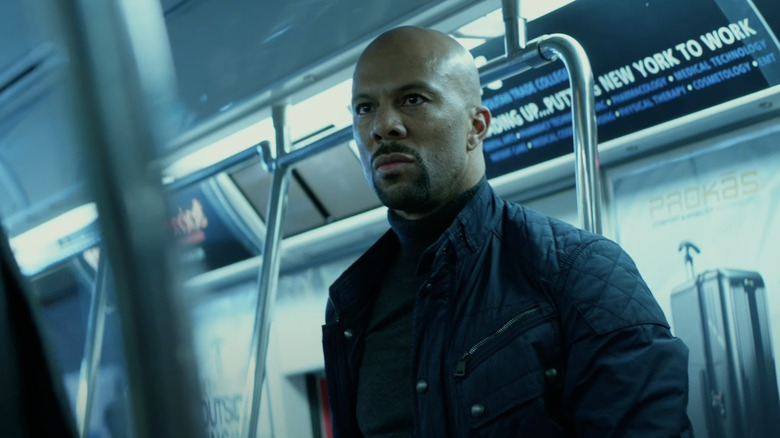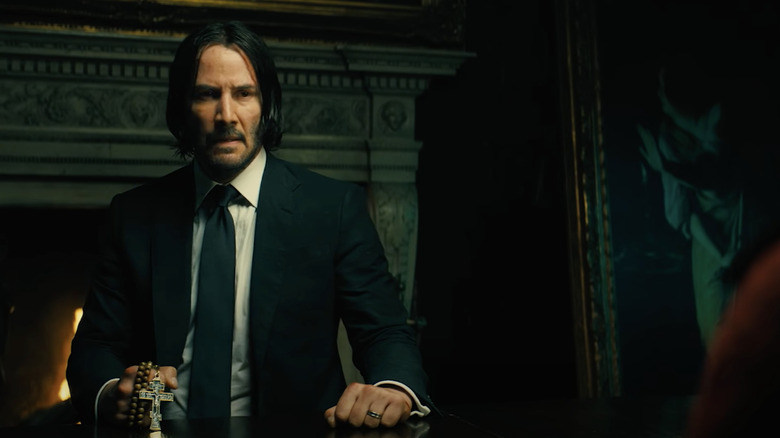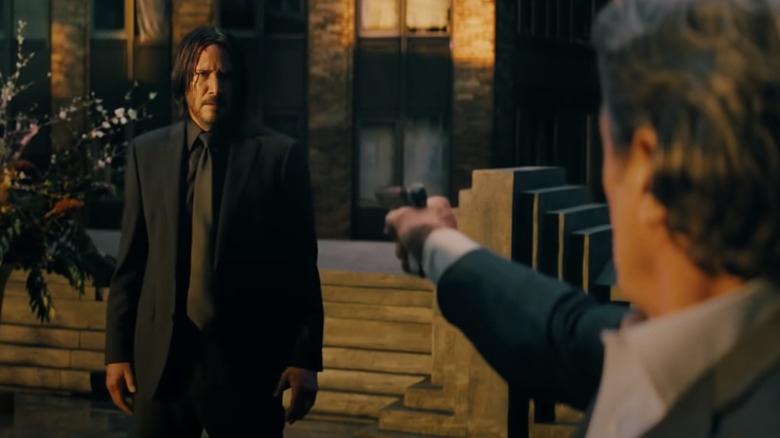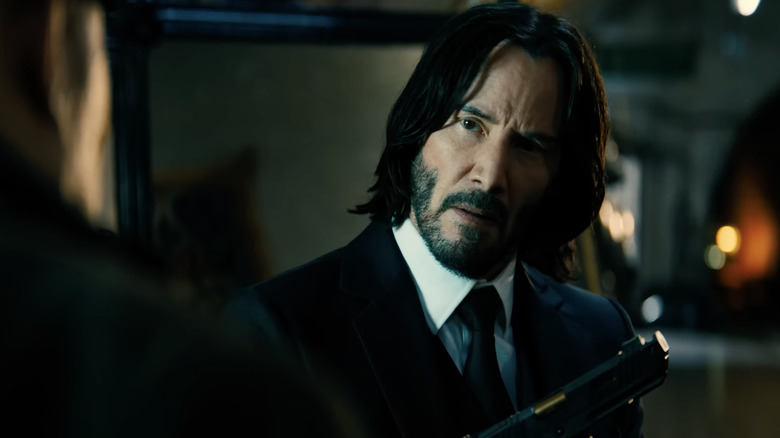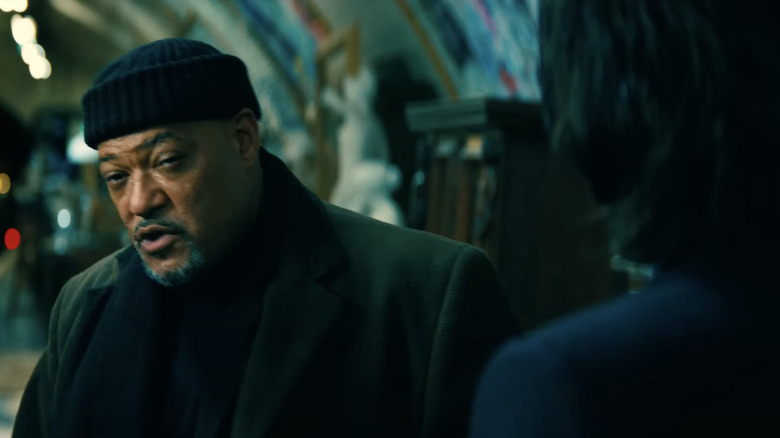John Wick Is A Stealth Horror Franchise Where The Slasher Is The Hero
The "John Wick" franchise is righteously hailed as a groundbreaking action series that defined the modern landscape of the genre — and will surely continue to do so in the wake of the fourth film's record-breaking opening weekend box office. Undoubtedly a large aspect of its success is the unique escapism it offers viewers — the wish fulfillment of being a stoic hitman who can kill his way out of any problem and survive a dozen car accidents and a tumble down all 200 steps to Sacre Coeur.
But what if we imagined ourselves not as a gloriously murderous version of Keanu Reeves, but as one of the many, many unlucky people that find themselves on the business end of his gun collection? From this point of view, "John Wick" would no longer be an action series, but a biting horror franchise.
Though some may dismiss this idea as a mere thought experiment, viewing "John Wick" as a horror story reveals narrative layers that may just border on the profound. Because you see, "John Wick" isn't just a horror series — it's a class-based horror series.
What is class-based horror, and how does John Wick fit into it?
Horror that revolves around class inequality is defined by the explicit (and often violent) conflict between groups at opposite ends of the socioeconomic spectrum. This conflict usually manifests itself in two types of horror stories.
The first of these we can call "working-class horror," represented in films like "Would You Rather?," "The Belko Experiment," or, perhaps most popularly, in the Netflix series "Squid Game." In these stories, members of the working and lower classes are coerced into performing horrible tasks in order to receive lifesaving charity, usually for the sadistic entertainment of rich voyeurs. The real-life terror it's meant to instill in its viewers is the terror of financial desperation — of having to make impossible choices to provide for yourself and others.
The second, which we'll call "upper-middle-class horror," evokes the terror of losing one's social position and becoming as powerless as the lower classes they used to ignore or oppress. Prime examples of this sub-subgenre would be films like "The Purge" or Jordan Peele's "Us," where imaginably wealthy, blissfully ignorant characters are tortured like the lower classes or by representations of the lower classes themselves.
The mechanics of working-class horror
In practice, class horror stories work like most normal horror stories in that victory is achieved by overcoming death. These heroes, though, are almost always exclusively successful through demonstrating class solidarity or becoming conscious of their place in the class system.
In working-class horror, the ultimate "victory" is often Pyrrhic, as the combative nature of the premise requires some moral sacrifice. The cardinal sin of all class horror is class betrayal — usually portrayed through the killing of a fellow worker. The protagonist of "Would You Rather?," Iris (Bethany Snow), competes in a mutually tortuous version of the titular game to pay for her brother's leukemia treatment. She "wins" the last round by killing Lucas (Enver Gjokaj), a fellow contestant who previously saved her life. Though the rich game masters allow her to leave with her prize, she arrives home only to find her brother had taken his own life in her absence, seeing himself as nothing but a financial burden on her life.
2016's "The Belko Experiment" ends with similar karmic punishment for its hopeless hero. After refusing to kill his coworkers for the entire film, Mike (John Gallagher Jr.) chooses to kill selfish COO Barry (Tony Goldwyn), becoming the sole survivor and "winning" the experiment. His reward? Capture, and the promise of a second experiment. And when Gi-hun (Lee Jung-jae) returns from the titular "Squid Game," having killed his childhood friend, his overwhelming guilt alienates him from society, eventually forcing him to re-enter the games once more.
All these films are obvious metaphors for capitalism, an economic system that these films see as brutally competitive. Thus, the argument their stories make is that the working poor cannot "win" capitalism: they can either survive in personal agony or die for the success of others.
Upper-middle-class horror holds a mirror up to its viewers
In upper-middle-class horror stories, characters succeed by achieving some kind of harmony with the lower classes. Stories with less complexity achieve this beat by forcing the character to show kindness to or sacrifice themselves for someone less privileged than themselves. At the end of the first "The Purge" film, the Sandin family is ultimately saved by the "Bloody Stranger" (Edwin Hodge), a homeless man afforded sanctuary during the annual murder holiday by the family's youngest son at the beginning of the film.
Films aiming to achieve deeper, more meaningful resolutions, however, will achieve this harmony by forcing the wealthy characters to recognize themselves within the lower classes. Of course, the clearest example of this is "Us," in which the heroes confront literal doppelgängers of themselves, identical on every level but experience. Where the Wilsons enjoyed success, leisure, and pleasure, their "Tethered" counterparts endured torture, neglect, and scarcity of resources. To defeat these counterparts, each family member has to confront what ties them together.
These types of films grow in relevance as middle classes around the globe continue to shrink and disappear. During times of existential economic hardship, families who would once discard lower or working classes as being unmotivated, uneducated, or unskilled are forced to confront their proximity to their circumstances. In a film like "Us," where the lower classes are the "villains" of the story, the killings can be viewed both as karmic punishment for social ignorance and cruelty, as well as a metaphor for impending economic equalization where all but the top 1% become powerless and endangered.
What are the hitmen of John Wick, then, but the working class?
The world of "John Wick" is undeniably one of class strife. The working class are the scores of hitmen operating around the world — people whose principals are only corrupted by financial ambition and professional obligations.
Though their bosses pay them in cold hard USD, their transactions amongst themselves are done through gold coins, manufactured and sanctioned by the ruling High Table. These coins represent the duality of the working class in "John Wick." One side reads "ENS CAUSA SUI," a Latin phrase that loosely translates to one who owes their existence to no one but themselves — a being with no governance but their own moral code. On the other, however, it reads "EX UNITAE VIRES" — "Strength Through Unity." This same Latin phrase was the "national motto" of South Africa while it was under white British rule. In addition to the implicit "us vs. them" propagandizing of the colonists uniting against the indigenous peoples, the motto asserted that the country was unified under foreign oppression. Similarly, the High Table-defined "unity" of the working class in "John Wick" only exists to serve the interests of capital. After all, this union vanishes the moment the ruling class deems someone "excommunicado."
John himself is an anomaly, having taken so many of the right lives that he was able to briefly live outside the system. While it's never stated who he killed, he did so in the service of mob boss Viggo Tarasov (Michael Nyqvist). In this context, John can be viewed as a working-class horror hero who made moral sacrifices to beat the system, only to be inevitably dragged back into it. In his tragic descent, however, John becomes something far more important — a menace to the upper classes.
John Wick isn't an action hero - he's a vengeful monster
John's transformation into the ultimate upper-class horror movie monster occurs in the first film. Even by action hero standards, John's lethal success is treated like a dreadful certainty, with Viggo telling his son Iosef (Alfie Allen), "John will come for you and you will do nothing — because you can do nothing." For "John Wick" villains, he's not an obstacle to overcome or an enemy to defeat — he's an unstoppable entity to be appeased or avoided, lest you incur his murderous wrath.
This profile fits far more in line with a slasher villain like Jason Voorhees or Michael Meyers, rather than action heroes like John McClain or even fellow Derek Kolstad-spawn Hutch Mansell. Nine times out of 10, it's not John's success that is decided by class factors, but the survival of those around him.
By their actions and "consequences," the characters of "John Wick" make up a complex yet crystal clear class hierarchy based on morals and class solidarity. In other words, if you wrong the working class, the Boogeyman is coming to get you.
Consider the perspective of John Wick's puppy killer, please
The original "John Wick" is an upper-class horror film about a father trying to protect the son he himself spoiled. It's from Viggo that Iosef learns to be violent with workers and to threaten others with his inherited power. If Iosef had killed anyone else's dog, Viggo likely couldn't have cared less. But he didn't — he killed John Wick's dog.
The Tarasovs secured their immense power via John's mythical completion of an "impossible task." In return, he was to be given safety and peace by his former employers. By violating their agreement for his own desires, Iosef awakened a vengeful spirit from the past.
In the scene in which Iosef is killed, there is no tension — only blood and horror. John's first strike comes through the window of Iosef's safe house like a jump scare, sending everyone around him into a helpless panic. Iosef's attempt to flee the area is shot from his perspective, centering his fear. If you choose to empathize with John, the righteous killer, his panic is cathartic and morbidly enjoyable. If you choose to empathize with Iosef, the sheltered kid raised in a cruel world, his anguish is less gratifying.
Whether or not John Wick's characters remain loyal to their fellow workers affects their fate
The first film also introduces Marcus (Willem Dafoe) and Perkins (Adrianne Palicki), morally opposed forces trying to survive John's wrath. Marcus represents class solidarity, as he refuses to kill John on behalf of the Tarasov family even though he had the opportunity to do so. Perkins, on the other hand, is a class traitor who violates Continental rules in order to make an attempt on John's life in exchange for Viggo's promised bounty.
Though they're both ultimately killed, their deaths have very different effects. Marcus is given a heroic last stand, in which he defiantly takes down several of Viggo's men before the boss himself has to intervene. On top of that, his death is so meaningful to John that it makes Viggo worthy of execution in his mind. Perkins, however, is unceremoniously dealt with in the dead of night by the very peers whose trust she violated. This dynamic of class loyalty versus class betrayal recurs throughout all four films, and becomes a key factor in the resolution of the story's overarching narrative in "Chapter 4."
Santino D'Antonio made a faustian deal
"John Wick: Chapter 2" plays out like a classic "deal with the devil" story — Winston Scott (Ian McShane) even says as much to the film's privileged "protagonist," Santino D'Antonio (Riccardo Scamarico). Envious of his sister's seat at the High Table, Santino uses a marker — a token of debt within the fold — to force John to kill her, vacating the seat and forcing John back into the world he desperately wants to escape.
Again, John's success is never in doubt. His forced acceptance of the marker is not dangerous for him, but for Santino. If "John Wick" is about the mistreatment of workers, "Chapter 2" could be seen as a cautionary horror story about coercive employment. In some social and economic theories, all employment is seen as coercive labor, as humans must make an income to survive. To present a slightly oversimplified example of this, people from rich families often have the freedom not to take low-paying hard labor, such as warehouse work, while those from low-income families lack such freedom. As such, coercive labor is viewed in these theories as a form of structural violence.
It's fitting that Santino's success in forcing John to do his violent bidding is ultimately his undoing in this upper-class horror story. Like the first film, "Chapter 2" emphasizes Santino's terror as he runs from John toward the Continental, seeking safety in the worker's sanctuary. Winston, siding with the ruling class, urges John to leave Santino alone. Instead, John shoots him in the head. Not one assassin technically serving beneath Santino raised so much as a finger as he did so, proving that coercion cannot itself generate true loyalty or respect.
John's quest may cost him his conscience
Once again, "Chapter 2" explores class solidarity through two contrasting characters — Santino's right-hand woman Ares (Ruby Rose), and his sister's former bodyguard Cassian (Common).
As a dutiful agent of the High Table, Ares is treated with slightly less scorn by the film than Perkins, who merely betrayed John for Viggo's money. She dies a painful but worthy death in direct conflict with the Baba Yaga, which is arguably a little better than getting discretely disposed of.
Cassian, however, is the first character to show how re-entering the world has chipped away at John's own sense of class solidarity. As John killed his ward, Cassian is driven by neither status nor money, but righteous vengeance. After defeating Perkins in the Continental, John seemingly empathized with her position and chose to spare her life. He makes a similar choice with Cassian in this film, but goes as far as stabbing him in a vital artery that will bleed out if Cassian removes the blade. This is the first hint that John's fight to survive will force him into direct conflict with those he once deemed colleagues, with the following chapter putting him on the dark path toward becoming a class traitor himself.
John Wick finally becomes the hero in Chapter 3
"John Wick: Chapter 3 — Parabellum" switches things up slightly by shifting from an upper-class horror film to a working-class horror film, with John becoming the hero. In this chapter, John is forced to slaughter his friends and coworkers who are themselves forced to turn on him by the High Table. The tragedy of this journey is emphasized by the respect, cordiality, and even kindness of John's attackers-slash-victims, especially final boss Zero (Mark Dacascos).
John's journey throughout this film is a gradual, painful, self-sacrificial descent into becoming a servant of power once more. To escape the city, he "tears his ticket" with the Ruska Roma, the closest thing to a family he's ever had aside from his wife Helen. In Morocco, John endures a torturous pilgrimage to the Elder, the High Table's governing member, who demands the tribute of his last remaining physical memory of his dead wife — his ring (and even the finger that carried it). This sacrifice grants him only the mere chance at redemption. To fully redeem himself, John must commit the ultimate act of class betrayal — he must assassinate Winston, the very man that secured his survival by granting him an hour's head start.
John Wick's choice to betray Winston is a low point for the character
Unfortunately, John initially resolves to kill Winston and live his life underneath the table. In the scenes leading up to his act, John seems truly defeated for the first time in the entire series. Before he pulls the trigger, however, Winston tells John that by returning to the fold he would die as the Boogeyman, rather than a man who loved and was loved by his wife. Essentially, he's convincing John that selling his soul to the table would rob him of his humanity and identity, reducing him to little more than a highly trained, highly dangerous corporate stooge (we see the torment of someone who made this exact deal with the Table in "Chapter 4").
And yet, though John changes his mind, his impulse to betray Winston arguably seals his fate. At that moment, he proves to Winston that he'd be willing to choose his own survival over his loyalty to a friend (as beneficial as John's reversal is, it comes as an effort to preserve his dwindling identity rather than his friendship with Winston). This may be why Winston ultimately chooses to dispassionately betray him to save his own skin at the end of the film.
John Wick finds true unity in Chapter 4
Of the films in the series, "John Wick: Chapter 4" is the least horrific by far — a suitable evolution for the storytelling, considering the film uses the class conventions established by its predecessors to redeem John from the Boogeyman to the loving husband.
The final installment in John's saga sees him mend his relationship with Winston (as much as possible, anyway), reunited over the loss of their mutual companion and the sanctuary that was the New York Continental. The course of the film also sees John reforge his ties to the Ruska Roma and deliberately save the lives of his two peers even as they try to assassinate him.
Together, the three killers unite outside the purview of the High Table to free themselves from its grasp. John spares Tracker/Mr. Nobody's (Shamier Anderson) life and saves his dog. As a direct result, Chidi (Marko Zaror) is killed and John is able to reach Sacre Coeur on time. During the subsequent duel, John allows Caine (Donnie Yen) to take his final shot uncontested, effectively sacrificing himself so that Caine may pay his debt to the High Table and be free. And then, John is given the chance to execute the Marquis de Gramont (Bill Skarsgård) in an official manner.
As Killa (Scott Adkins) implies, one cannot escape this system on their own through service, money, or blood (even John was eventually dragged back in by Santino). The message of the film — and arguably the entire series — is clear. No one — not even a man with the power of judge, jury, and executioner — can withstand the combined will of workers united in solidarity for their own liberation.
Whether John Wick's class horror subtext is intentional or not, it still stands
As to whether or not Derek Kolstad, Chad Stahelski, Shay Hatten, or any others involved had set out to make a class horror series is truly anyone's guess. Without venturing too far into the dangerous water that is attempting to psychoanalyze an artist, it's at least interesting to consider the uniqueness of Stahelski's professional background.
Arguably the definitive creative voice in the "John Wick" canon, Stahelski was previously a stunt performer, coordinator, and second-unit director — three professions that receive little recognition by Hollywood standards. Perhaps a career of dangerous, vital, and yet often thankless work informed how he approached this series. It's also worth noting that "Day Shift" — another action flick produced by Stahelski and written by Hatten — features a blue-collar, working-class vampire hunter fighting against monsters hellbent on gentrifying the San Fernando Valley.
Creative intentions or lack thereof notwithstanding, enjoying the series through a lens of class, privilege, and consequence provides for a richer viewing experience brimming with relevant themes and ideas. What other multimillion-dollar series — horror or action — makes as strong a case for collective action? It will be fascinating to see where the franchise takes these ideas in the future. We didn't even touch upon The Bowery, a representation of the collective power of the disenfranchised who expanded their global presence independent of the Table during "Chapter 4," or how Caine must still suffer the consequences of his transgressions against his fellow workers.
Whether by accident or design, the "John Wick" franchise will likely continue to examine the systems that shape our world in ways equally inventive and effective. Or they'll throw Keanu Reeves down 200 more stairs. Either works.
